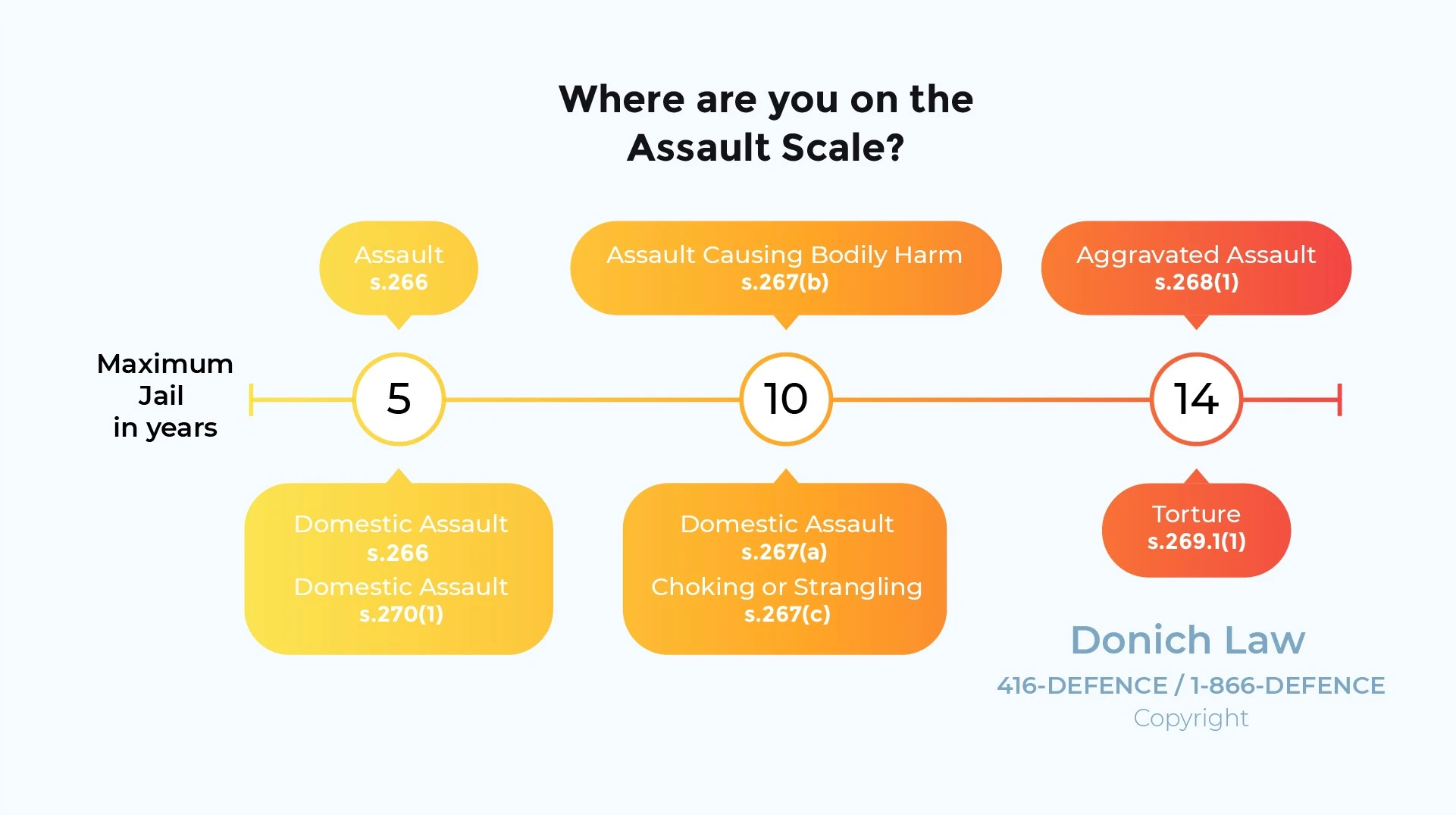
Defend Assault Charges
Crime Statistics
Statistics Canada collects data on incidents of common assault, also known as simple assault, as well as on major assaults, including assault causing bodily harm, assault with a weapon, and aggravated assault. Assault is among the most common offences committed across Canada. Assault occurs when an individual makes physical contact with another person without that person’s consent.
In 2021 and 2022, the number of individuals convicted of a major assault dropped to 7,422. Of that number, just over 42% were sentenced to a period of custody. Roughly 40% of all assaults in Canada are considered violent assault.
Our Experience
In R. v. Y.W. [2022], Donich Law successfully defended an individual charged with assault with a weapon, assault and uttering death threats. The accused was arrested and charged after his domestic partner reported that he had threatened her with a kitchen knife and hit her during an argument. The Firm engaged in several months of Crown negotiations, ultimately securing a withdrawal of all charges.
In R. v. S.Y. [2022], Donich Law represented an individual charged with one count of assault and one count of assault with a weapon after an alleged altercation with her ex-partner. The accused was alleged to have hit the complainant with her hands while holding a cell phone. Police were called by an uninvolved third-party who witnessed the incident. The Firm engaged in negotiations with the Crown for some time before ultimately securing a withdrawal of both charges.
In 2021, Donich Law successfully represented an individual charged with indecent communications, criminal harassment and false communications in R. v. B.K. [2021]. The accused allegedly used a fake Instagram account to send messages to a mutual friend of he and his ex-girlfriend, indicating that the ex-girlfriend wanted to engage in sexual activity with the mutual friend. The mutual friend altered the ex-girlfriend who was alarmed by the information and reported the matter to police. Donich Law engaged in Crown negotiations for more than a year, uncovering weaknesses in the Crown’s case. The Firm ultimately resolved the matter without a criminal record.

- CP24: Civil Sexual Assault Lawsuit at St. Michael’s in Toronto.
- Global News Morning Show: Sentencing Arguments in Assault case of Dafonte Miller.
- Breakfast Television: Role of Mental Health in Court Proceedings.
- Global News National: Bruce McArthur will not serve consecutive sentences.
- CBC Radio: Interview with Mayor John Tory and Jordan Donich on CBC Radio.
- CTV News National: Handgun ban supported by majority of Canadians: Nanos survey.
- Global News: How difficult is it to get a legal handgun in Canada.
- CP24: Sentencing Hearing for Chair Girl.


In the 2021 Annual Report by the Guelph Police Services, cases of assault dropped from 633 cases in 2020, to 547 cases in 2021. According to the 2019 Annual Report, there were 638 cases of assault in 2018, the number dropping to 586 in 2019. Guelph is a township of 120,000 people to the west of Toronto. A serious and violent crime, assault is a charge that can be debilitating to the accused and the accused’s personal life. After being charged with assault, it is important to protect your rights and retain a lawyer.
In 2021, the Firm successfully represented an individual charged with assault with a weapon and assault in R. v. J.D. [2021]. The client was arrested after his domestic partner alleged that he held a knife and pushed her during a heated argument. After months of Crown negotiations, the Firm secured a withdrawal of both charges, resolving the matter without a criminal record for the accused.
In 2021, the Firm represented an accused charged with 2 counts of assault, assault with a weapon, forcible confinement and uttering death threats in R. v. B.W. [2021]. The Firm successfully defended the charges by demonstrating on cross-examination that the complainant had fabricated and exaggerated the allegations by pointing out material inconsistencies in her evidence.
Jail Sentences for Assault Charges in Canada

In 2021, Donich Law represented an individual charged with simple assault after allegedly hitting his wife during an argument in R. v. A.R. [2021]. A no contact order was put in place by the court, leaving the couple unable to communicate. The complainant hired independent legal counsel to assist her in varying the order. The Firm and complainant’s counsel provided a unified defence, ultimately allowing the Firm to negotiate for a withdrawal of the charge.
In 2019, the Firm represented an individual charged with assault causing bodily harm after getting into an altercation with the complainant in R. v. Z.C. [2019]. After litigating the matter for over a year, the Firm was able to resolve the matter without a criminal record. In R. v. A.V. [2019] and R. v. M.R. [2019], the Firm secured withdrawals for two separate clients both of whom were second time offenders charged with assault.
In 2018, the Firm represented an individual charged with one count of assault and four counts of assault with a weapon in R. v. E.T. [2018]. In that case, the Firm was able to secure the withdrawal of all charges. In 2017, the Firm represented a healthcare employee charged with assault with a weapon after throwing burnt pizza at her spouse, causing injuries in R. v. W.V. [2017]. The Firm was able to negotiate with the Crown to secure a withdrawal.
How to Defend Assault Charges
In 2016, the Firm represented an individual charged with assault with a weapon after threatening his domestic partner with a kitchen knife in R. v. P.T. [2016]. After litigating the case for some time, the Firm was able to secure a withdrawal. In 2016, the Firm resolved an assault causing bodily harm charge where the accused was alleged to have kicked a child during a Blue Jays game in R. v. N.S. [2016]. After negotiating with the Crown, the Firm was able to resolve the matter without a criminal record for the accused.
In R. v. R.S. [2016], The Firm resolved an assault causing bodily harm charge without a criminal record for the accused. In that case, the accused caused significant facial injuries to the complainant after being involved in an altercation. After litigating the matter for three years, the Firm was able to present evidence to the Court to show that the accused had punched the complainant only after the complainant sexually harassed the accused’s girlfriend.
In 2022, the Firm defended a client charged with simple assault in R. v. G.S. [2022]. The accused, a daycare worker, was charged after grabbing a child and causing the child to lose balance and hit her face off a piece of furniture. The Crown originally sought a period of custody for the accused. The Firm engaged in two years of Crown negotiations and pre-trials and the client underwent a forensic risk assessment. The Firm ultimately resolved the matter without a criminal record for the accused.
Law Newbie is a free AI research assistant that can help you safely answer questions about criminal law.




Frequently Asked Questions
What Evidence Does the Crown Need for a Conviction? What If There Is No Evidence?
For an assault conviction, the Crown must prove the person’s identity, the date/range of dates of when the incident occurred, and the jurisdiction that it happened in. In addition, the Crown must always prove the person accused threatened or applied some sort of force directly or indirectly to the other person. They must prove that the accused did so intentionally.
When dealing with an assault with a weapon charge, the Crown must prove the presence and possession of a weapon, either used or used to threaten the complainant.
Typically, in assault cases, there is little to no real, physical evidence. If there is no physical evidence or third party witnesses, testimony from the victim is often sufficient for the Crown to prove assault. The victim becomes the star witness and testifies. If the victim’s testimony is reliable and credible, it is enough for a conviction. All the Crown needs is the victim’s testimony.
The Need for Two Lawyers – Family and Criminal in Guelph?
In cases of domestic assault, the accused would likely need two lawyers. After the report of an assault, a no contact order is made so that the victim will remain safe. If children were involved in the assault, there would be a no contact order for the children as well.
If the accused and the victim share a residence, the victim is allowed to remain in the residence while the accused must typically leave due to the no contact order. Even in cases where the accused owns the property, the accused must comply with the no contact order and find another residence. If a separation is forthcoming, any shared assets would need to be re-allocated and divided.
Can You Be Charged with Assault for Defending Yourself?
Yes, you can be charged with assault for defending yourself. Self-defence is a defence that the accused must go to trial to prove. There are strict rules to prove a self defence. The self defence must be necessary and the accused can only use enough force to repel the attack. Unlike in American jurisdictions, there is no “stand your ground” clause in Canadian law. If a person is wounded during a self-defense altercation, as in the case of R. v. Meadows, the defendant may be charged with assault causing bodily harm.
Can You Legally Shoot an Intruder in Guelph?
No, you cannot legally shoot an intruder. Unlike in American jurisdictions, Canadian law has no “stand your ground clause.” Legally, though you are not required to retreat, you are encouraged to as the Court would consider whether “there were other means available to respond to the potential use of force.” (Criminal Code, RSC 1985, c C-46, s 34(2)). When defending one’s property, the owner can only use amount of force that is necessary to expel the intruder.
To prove self-defence or defence of property, there will usually need to be a trial. During the trial, the Court must consider multiple factors to determine whether or not the act committed is reasonable in the circumstances. Circumstantial factors include: the nature of force or threat; the imminency of the threat; the person’s role; the history of the parties; the physique, gender, and age of the parties; the presence of a weapon; the proportionality of the retaliation; and the lawfulness of a threat. Only after considering these factors can the Court give a verdict on whether or not the defence is valid. When in a dangerous situation, disengaging, retreating, and calling for help is often the legally sensible course of action.
Common Complications with Domestic Assaults
There may be many complications that come with domestic assaults. In the case of a domestic assault, should the couple be cohabitating, the no contact order removes the accused from the home. If children are involved with the assault case, the no contact order may include the child as well. This will bar the accused from visiting their own children. In these cases, a family court order may be required to lift the no contact order.
If the accused is trying to continue the relationship with the victim, the no contact order would also bar that from happening. The no contact order also extends to passing messages through mutual friends and social groups, as any indirect contact even through a third party is prohibited. If the accused works or is in school with the victim, the accused may be removed from the institution, and this may affect their finances or their education.
Recent Cases
R. v Meadows, 2023 ONSC 2695
In the Superior Court of Justice case of R. v. Meadows, the Appellant was charged and convicted of Assault Causing Bodily Harm. Seeking to set this judgement aside, the Appellant pleaded self defence. The case arose out of an altercation between Meadows and Suter, who believed he had a relationship with Clough. Meadows was discovered in Clough’s home, and Suter assaulted him with a knife. After the knife assault, Meadows uttered, “I’m not fucking done with you yet.” After this, Suter claimed that Meadows assaulted him in the bathroom.
The Yebes test becomes part of the fundamental principle for this case to be overturned, as it sets the threshold for what was considered an unreasonable judgement. Taking into factors such as Meadows’ utterance of “I’m not fucking done with you yet,” the Court of Appeal found that the trial judge erred in inferring from Meadows’ utterance that a second assault occurred. It was found that there was no correlation between “I’m not fucking done with you yet” and a further assault occurring. The Appellant, Meadows, won and the conviction for assault was set aside.
R. v. Epure, 2019 ONSC 772
In the Superior Court of Justice case of R. v. Epure, the appellant was charged with assault causing bodily harm and assault. This was during an altercation at a Guelph Transit platform at the University of Guelph between a group of young persons. The victim, Brett Nicholson, was unconscious on the ground and his girlfriend, Rachel Figueira, was struck. After a verbal exchange, Figuiera struck Epure, who retaliated. Nicholson was beaten up by the appellant’s friends, suffering heavy injuries.
The Court considered a series of aggravating and mitigating factors that contribute to the sentencing. Aggravating factors include but are not limited to: the extent of the victim’s injuries, the unconsciousness of the victim after the appellant joined the fight, and the group nature of the conflict. Due to mitigating factors such as the appellant’s remorse, his lack of a criminal record, and it not being contrary to the public interest, the appellant was sentenced to a conditional discharge, along with a DNA order a a s. 110 weapons prohibition for five years.
R. v. Moses, 2023 ONCJ 165
In The Ontario Superior Court Case of R v. Moses, Moses was charged with aggravated assault due to the injuries the victim, R.H. suffered. Moses was at a bar when he was assaulted by R.H., who knew him prior to the event. The issue was whether or not self-defence was a valid defence for this case.
The defence of self-defence will typically go to trial. During the trial, the Court considered several factors for self-defence, including but not limited to: the reasonable belief of threat; the nature of the force/threat; the imminency of the force; the person’s role; the presence of weapons; the parties’ histories; the size, age, gender, and physical capabilities of the parties; and the proportionality of the response.
Analyzing the physical threat R.H. posed against Mr. Moses, the Court decided that Mr. Moses did not respond appropriately to the threat. R.H. had punched Mr. Roses, but the punches were weak and did not knock Mr. Moses “off balance or affect him significantly.” The Court ruled that Mr. Moses’ retaliation of hitting her with a bottle was not proportional to the use of force. The Court found Mr. Moses guilty of aggravated assault.












